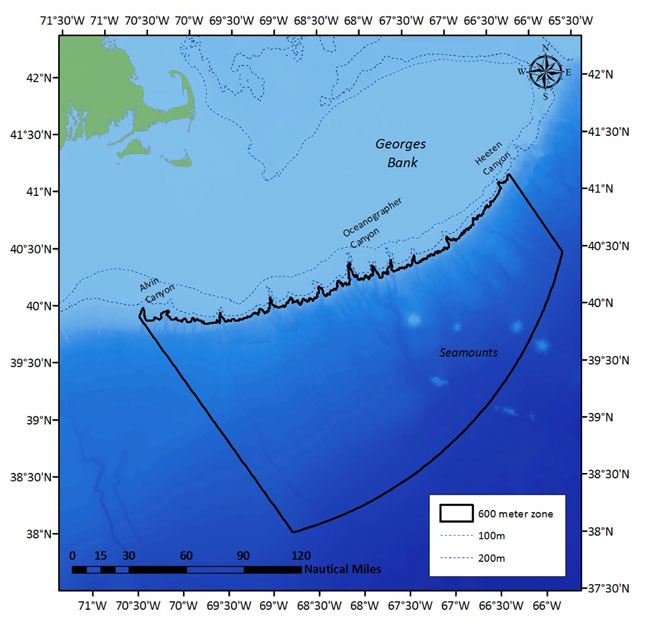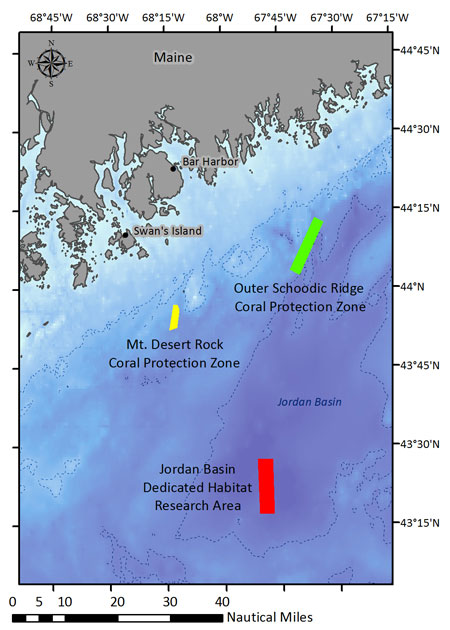Coral Protection Zones to Ban Fishing Gear
Continued from March 2018 Homepage
Maneuverability is key
to avoiding lobster gear.
We need room
to maneuver.
– Megan Lapp,
Seafreeze Ltd., RI
According to a NEFMC press release, the 600-meter broad zone was known as Option 6 in the coral amendment. NEFMC also considered an additional proopsla put forward by environmental groups. Known as Option 7, the proposal covered more bottom and included shallower depths, ranging between 300 meters and 550 meters. Option 7 would have prohibited mobile bottom-tending gear but not fixed gear.
NEFMC also considered Option 6/7, which combined Option 7 for mobile bottom-tending gear and Option 6 for all bottom-tending gear.
One NEFMC member favored the combined Option 6/7 as a way to optimize coral protection with minimal impacts to the industry. And Greg Wells, a senior associate at Pew Charitable Trusts, said that including Option 7 was the best approach. “This option is a more data-driven approach, closely tracking the spatial footprint of coral habitat and current fishing effort,” Wells said. “Option 7 protects 15 to 20 percent more coral habitat than if Option 6 were adopted alone.” Option 7, he said, also most effectively freezes the footprint of current trawl activity.
But Meghan Lapp, an industry representative for Seafreeze Ltd. in Kingstown, R.I., said Option 7 would cut current fishing effort and highly impact fishermen who fish longfin squid, silver hake, and butterfish. The number of those fishermen is small—just two vessels in 2016, she said. But their landings, which go to Seafreeze, would be substantially affected, affecting the boats and the plant, she said.

The New England Council approved a 600-meter minimum depth broad zone to protect deep-sea corals south of Georges Bank. Four seamounts and 20 deep-sea canyons are protected within the zone. NEMFC graphic
“It impacts us heavily,” Lapp said. She added, “In the New England area, we have something the mid-Atlantic doesn’t have: That is a thriving offshore lobster fishery. Maneuverability is key to avoiding lobster gear. We need room to maneuver. The Option 7 boundary cuts off some fishing effort.” Much of that effort, she said, is close to the proposed Option 7 boundary line. She added that Seafreeze supported Option 6.
Katie Almeida, a fishery policy analyst at The Town Dock, a calamari supplier Narragansett, R.I., said her company also supported Option 6.”Option 7 is not about freezing the [fishery] footprint but also about reducing the footprint,” Almeida said. “We own seven offshore draggers that will be negatively impacted. Not only our vessels, but others in our port.” Almeida said Option 7 will result in loss of access to more areas and an increase in gear conflicts, in an area that’s popular for lobster and crab gear. “They have traditional fishing areas, and now we’ll be competing with that.” The situation is already exacerbated, she added, by the prospect of wind energy development below Massachusetts, with large vessels expecting to be impacted by those areas.
“It’s been said it’s only a
handful of vessels.
It’s a big handful.”
– Eric Reid, NEFMC member
Jeff Kaelin, a government relations specialist at Lund’s Fisheries in Cape May, N.J., said the firm also opposed Option 7. “There are a few people who, the data show, will lose about a third of their annual access to squid and butterfish,” Kaelin said. “We do buy squid from fishermen who go all the way out to the edge regularly. Option 6 protects their access and really freezes the footprint.”
Adding in Option 7, he said, doesn’t freeze the fishing footprint but only takes away fishing access from some fishermen. “There are only nine illex [squid] fishermen from the mid-Atlantic to the Canadian border. Those catches haven’t even been analysed in terms of what might be displaced. They’re operating right up the to the edge. Most importantly, those boats aren’t having any impact on corals. The projection that corals are there is justification for eliminating their access. But they’re fishing light bottom-tending gear. They’re not designed to go into the rocks or the hard coral.” Option 6 would be the right choice, he said.

Gulf of Maine Coral Protection Zones and Dedicated Habitat Research Area. NEMFC graphic
David Borden, executive director of the Atlantic Offshore Lobstermen’s Association, said his organization also opposed Option 7. One of the key considerations in the amendment, he said, is enforceability. Option 6/7 would create two boundary lines to enforce. “I’m thinking we’re asking way too much of the Coast Guard to try to enforce two lines—one line to enforce mobile gear and another for fixed gear.” He added, “The big difference between these two alternatives is the impact on up to 20 boats. And there is going to be a significant impact, potentially, on those 20 boats, for species that are basically underutilized—whiting, squid, and butterfish.” In addition, he said, the combined options could force displaced boats into areas that are traditionally fished by other gear, like lobster and crab, which could in turn displace lobster and crab gear.
NEFMC member Eric Reid said he opposed including Option 7. “Option 7 is targeted specifically for bottom trawling and scallops, and I can’t accept something that targets a single gear type in any way, shape, or form,” Reid said. The impact of Option 7 would be huge, he added. “It’s been said it’s only a handful of vessels. It’s a big handful. Those are million and millions of dollars of investments by these vessels that are designed specifically to fish in and around those areas. That investment will be wasted.”
Once the amendment is implemented, changes to the following provisions will be allowable through framework adjustments:
• adding, revising, or removing coral protection zones;
• changing fishing restrictions;
• development of coral zone fishery access programs and/or exploratory fishing programs.
